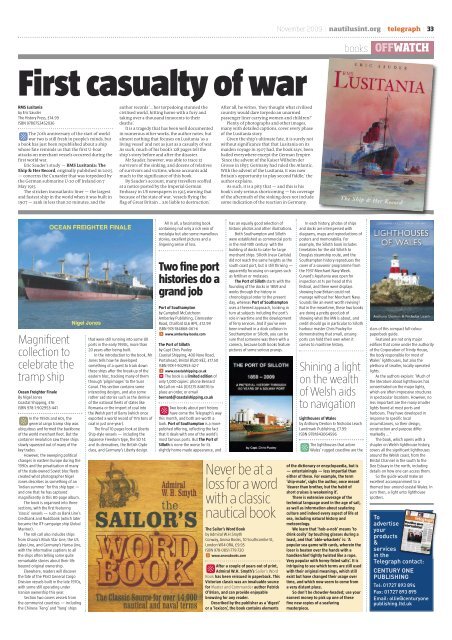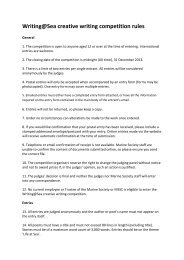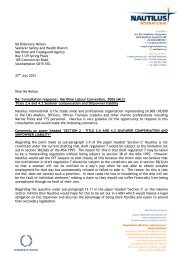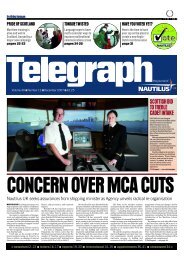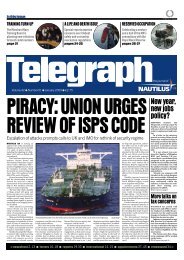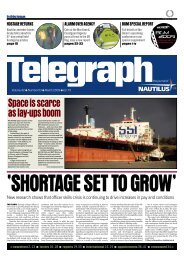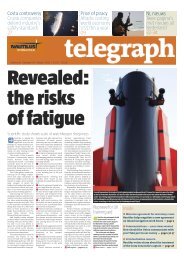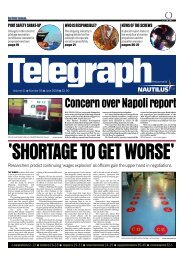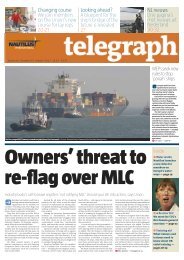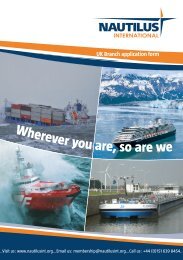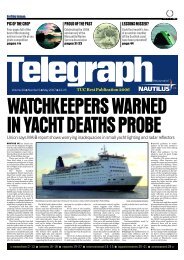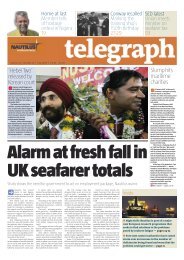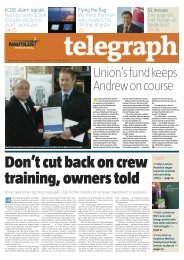NAUTILUS P01 NOVEMBER 2009.qxd - Nautilus International
NAUTILUS P01 NOVEMBER 2009.qxd - Nautilus International
NAUTILUS P01 NOVEMBER 2009.qxd - Nautilus International
Create successful ePaper yourself
Turn your PDF publications into a flip-book with our unique Google optimized e-Paper software.
November 2009 | nautilusint.org | telegraph | 33<br />
books<br />
OFFWATCH<br />
First casualty of war<br />
RMS Lusitania<br />
by Eric Sauder<br />
The History Press, £14.99<br />
ISBN 9780752452036<br />
The 70th anniversary of the start of world<br />
Kwar two is still fresh in people’s minds, but<br />
a book has just been republished about a ship<br />
whose fate reminds us that the first U-boat<br />
attacks on merchant vessels occurred during the<br />
first world war.<br />
Eric Sauder’s study — RMS Lusitania: The<br />
Ship & Her Record, originally published in 2005<br />
— concerns the Cunarder that was torpedoed by<br />
the German submarine U-20 off Ireland on 7<br />
May 1915.<br />
The stricken transatlantic liner — the largest<br />
and fastest ship in the world when it was built in<br />
1907 — sank in less than 20 minutes, and the<br />
author records ‘… her torpedoing stunned the<br />
civilised world, hitting home with a fury and<br />
taking over a thousand innocents to their<br />
deaths’.<br />
It is a tragedy that has been well documented<br />
in numerous other works, the author notes, but<br />
almost nothing that focuses on Lusitania ‘as a<br />
living vessel’ and not as just as a casualty of war.<br />
As such, much of his book’s 128 pages tell the<br />
ship’s story before and after the disaster.<br />
Mr Sauder, however, was able to trace 12<br />
survivors of the sinking, and dozens of relatives<br />
of survivors and victims, whose accounts add<br />
much to the significance of this book.<br />
By Sauder’s account, many travellers scoffed<br />
at a notice posted by the Imperial German<br />
Embassy in US newspapers in 1915 warning that<br />
because of the state of war, ‘vessels flying the<br />
flag of Great Britain … are liable to destruction’.<br />
After all, he writes, ‘they thought what civilised<br />
country would dare torpedo an unarmed<br />
passenger liner carrying women and children?’<br />
Plenty of photographs and other images,<br />
many with detailed captions, cover every phase<br />
of the Lusitania story<br />
Given the ship’s ultimate fate, it is surely not<br />
without significance that that Lusitania on its<br />
maiden voyage in 1907 had, the book says, been<br />
hailed everywhere except the German Empire.<br />
‘Since the advent of the Kaiser Wilhelm der<br />
Grosse in 1897, Germany had ruled the Atlantic.<br />
With the advent of the Lusitania, it was now<br />
Britain’s opportunity to play second fiddle,’ the<br />
author explains.<br />
As such, it is a pity that — and this is his<br />
book’s only serious shortcoming — his coverage<br />
of the aftermath of the sinking does not include<br />
some indication of the reaction in Germany.<br />
Magnificent<br />
collection to<br />
celebrate the<br />
tramp ship<br />
Ocean Freighter Finale<br />
By Nigel Jones<br />
Coastal Shipping, £16<br />
ISBN 978-1-902953-441<br />
In the 1950s and 60s, the<br />
Kgeneral cargo tramp ship was<br />
ubiquitous and formed the backbone<br />
of the world merchant fleet. But the<br />
container revolution saw these ships<br />
slowly squeezed out of many of the<br />
key trades.<br />
However, the sweeping political<br />
changes in eastern Europe during the<br />
1990s and the privatisation of many<br />
of the state-owned Soviet bloc fleets<br />
created what photographer Nigel<br />
Jones describes as something of an<br />
‘Indian summer’ for this ship type —<br />
and one that he has captured<br />
magnificently in this 80-page album.<br />
The book is organised into three<br />
sections, with the first featuring<br />
‘classic’ vessels — such as Bank Line’s<br />
Crestbank and Ruddbank (which later<br />
became the ITF campaign ship Global<br />
Mariner).<br />
The roll call also includes ships<br />
from Ghana’s Black Star Line, the US<br />
Lykes Line, and Germany’s Hansa Line,<br />
with the informative captions to all<br />
the ships often telling some quite<br />
remarkable stories about their life<br />
beyond original ownership.<br />
Elsewhere, readers will discover<br />
the fate of the P&O General Cargo<br />
Division vessels built in the late 1970s,<br />
with some still operating under<br />
Iranian ownership this year.<br />
Section two covers vessels from<br />
the communist countries — including<br />
the Chinese ‘Feng’ and ‘Yang’ ships<br />
that were still running into some UK<br />
ports in the early 1990s, more than<br />
20 years after being built.<br />
In the introduction to the book, Mr<br />
Jones tells how he developed<br />
something of a quest to track down<br />
these ships after the break-up of the<br />
eastern bloc, tracking many of them<br />
through ‘pilgrimages’ to the Suez<br />
Canal. This section contains some<br />
interesting designs, and also some<br />
rather sad stories such as the demise<br />
of the national fleets of states like<br />
Romania or the import of coal into<br />
the Welsh port of Barry (which once<br />
exported a world record of 11m tons of<br />
coal in just one year).<br />
The final 10 pages look at Liberty<br />
Ship-style vessels — including the<br />
Japanese Freedom type, the SD 14<br />
and its derivatives, the British Clyde<br />
class, and Germany’s Liberty design.<br />
All in all, a fascinating book<br />
containing not only a rich vein of<br />
nostalgia but also some marvellous<br />
stories, excellent pictures and a<br />
lingering sense of loss.<br />
Two fine port<br />
histories do a<br />
grand job<br />
Port of Southampton<br />
by Campbell McCutcheon<br />
Amberley Publishing, Cirencester<br />
Road, Chalford GL6 8PE, £12.99<br />
ISBN 978-184868-061-6<br />
f www.amberley-books.com<br />
The Port of Silloth<br />
by Capt Chris Puxley<br />
Coastal Shipping, 400 Nore Road,<br />
Portishead, Bristol BS20 8EZ, £17.50<br />
ISBN 978-1-902953-42-7<br />
f www.coastalshipping.co.uk<br />
g The book is a limited edition of<br />
only 1,000 copies: phone Bernard<br />
McCall on +44 (0)1275 846176 to<br />
place an order, or email<br />
bernard@coastalshipping.co.uk<br />
Two books about port history<br />
Khave come the Telegraph’s way<br />
this month, and both are worth a<br />
look. Port of Southampton is a more<br />
polished offering, reflecting the fact<br />
that it deals with one of the world’s<br />
most famous ports. But The Port of<br />
Silloth is none the worse for its<br />
slightly home-made appearance, and<br />
has an equally good selection of<br />
historic photos and other illustrations.<br />
Both Southampton and Silloth<br />
were established as commercial ports<br />
in the mid-19th century with the<br />
building of docks to cater for large<br />
merchant ships. Silloth (near Carlisle)<br />
did not reach the same heights as the<br />
south coast port, but is still thriving —<br />
apparently focussing on cargoes such<br />
as fertiliser or molasses.<br />
The Port of Silloth starts with the<br />
founding of the docks in 1859 and<br />
works through the history in<br />
chronological order to the present<br />
day, whereas Port of Southampton<br />
uses a themed approach, looking in<br />
turn at subjects including the port’s<br />
role in wartime and the development<br />
of ferry services. And if you’ve ever<br />
been involved in a dock collision in<br />
Southampton or Silloth, you can be<br />
sure that someone was there with a<br />
camera, because both books feature<br />
pictures of some serious prangs.<br />
Never be at a<br />
loss for a word<br />
with a classic<br />
nautical book<br />
The Sailor’s Word Book<br />
by Admiral W.H.Smyth<br />
Conway, Anova Books, 10 Southcombe St,<br />
London W14 0RA, £9.95<br />
ISBN 978-0851-779-720<br />
f www.anovabooks.com<br />
After a couple of years out of print,<br />
KAdmiral W.H. Smyth’s Sailor’s Word<br />
Book has been reissued in paperback. This<br />
Victorian classic was an invaluable source<br />
for Master and Commander author Patrick<br />
O’Brian, and can provide enjoyable<br />
browsing for any reader.<br />
Described by the publisher as a ‘digest’<br />
or a ‘lexicon’, the book contains elements<br />
In each history, photos of ships<br />
and docks are interspersed with<br />
diagrams, maps and reproductions of<br />
posters and memorabilia. For<br />
example, the Silloth book includes<br />
timetables for the old Silloth to<br />
Douglas steamship route, and the<br />
Southampton history reproduces the<br />
cover of a souvenir programme from<br />
the 1937 Merchant Navy Week.<br />
Cunard’s Aquitania was open for<br />
inspection at 1s per head at this<br />
festival, and there were displays<br />
showing how Britain could not<br />
manage without her Merchant Navy.<br />
Sounds like an event worth reviving!<br />
But in the meantime, these two books<br />
are doing a pretty good job of<br />
showing what the MN is about, and<br />
credit should go in particular to Silloth<br />
harbour master Chris Puxley for<br />
demonstrating that small, unsung<br />
ports can hold their own when it<br />
comes to maritime history.<br />
Shining a light<br />
on the wealth<br />
of Welsh aids<br />
to navigation<br />
Lighthouses of Wales<br />
by Anthony Denton & Nicholas Leach<br />
Landmark Publishing, £7.99<br />
ISBN 9781843064596<br />
The lighthouses that adorn<br />
KWales’ rugged coastline are the<br />
of the dictionary or encyclopaedia, but is<br />
— entertainingly — less impartial than<br />
either of these. For example, the term<br />
‘ship-mate’, sighs the author, once meant<br />
‘dearer than brother, but the habit of<br />
short cruises is weakening it’.<br />
There is extensive coverage of the<br />
technical language used in the age of sail,<br />
as well as information about seafaring<br />
culture and indeed every aspect of life at<br />
sea, including natural history and<br />
meteorology.<br />
We learn that ‘hob-a-nob’ means ‘to<br />
drink cosily’ by touching glasses during a<br />
toast, and that ‘able-whackets’ is: ‘A<br />
popular sea game with cards, wherein the<br />
loser is beaten over the hands with a<br />
handkerchief tightly twisted like a rope.<br />
Very popular with horny-fisted salts’. It is<br />
intriguing to see which terms are still used<br />
with their original meanings, which still<br />
exist but have changed their usage over<br />
time, and which now seem to come from<br />
a very distant place.<br />
So don’t be chowder-headed; use your<br />
earnest money to pick up one of these<br />
fine new copies of a seafaring<br />
masterpiece.<br />
stars of this compact full-colour<br />
paperback guide.<br />
Featured are not only major<br />
edifices that come under the authority<br />
of the Corporation of Trinity House,<br />
the body responsible for most of<br />
Wales’ lighthouses, but also the<br />
plethora of smaller, locally operated<br />
lights.<br />
As the authors explain: ‘Much of<br />
the literature about lighthouses has<br />
concentrated on the major lights,<br />
which are often impressive structures<br />
in spectacular locations. However, no<br />
less important are the many smaller<br />
lights found at most ports and<br />
harbours. They have developed in<br />
response to specific local<br />
circumstances, so their design,<br />
construction and purpose differ<br />
markedly … ’<br />
The book, which opens with a<br />
chapter on Welsh lighthouse history,<br />
covers all the significant lighthouses<br />
around the Welsh coast, from the<br />
Bristol Channel in the south to the<br />
Dee Estuary in the north, including<br />
details on how one can access them.<br />
So the guide would make an<br />
excellent accompaniment to a<br />
themed tour around coastal Wales. In<br />
sum then, a light unto lighthouse<br />
spotters.<br />
To<br />
advertise<br />
your<br />
products<br />
&<br />
services<br />
in the<br />
Telegraph contact:<br />
CENTURY ONE<br />
PUBLISHING<br />
Tel: 01727 893 894<br />
Fax: 01727 893 895<br />
Email: ollie@centuryone<br />
publishing.ltd.uk


